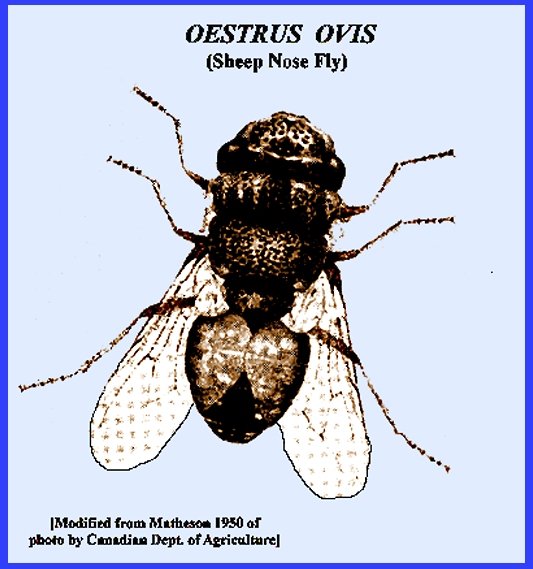File: <oestridaemed.htm> <Medical
Index> <General Index> Site Description Glossary <Navigate to Home>
|
Arthropoda: Insecta OESTRIDAE (Contact) Please
CLICK on
underlined links to view: Also See: <Oestridae
Details>
Several
serious botflies, Gasterophilus spp.,
are discussed as follows: Horse
Botflies., -- These flies produce eggs that
are swallowed by horses, after which the hatched spiny larvae attach
themselves to the wall of the horse's intestines. Horses lose energy and weight following infection. The flies overwinter in their alimentary
canal and the larvae mature in late winter or spring. The maggots attach themselves to the
stomach lining. They detach in late
spring and burrow into the soil to pupate.
Adults emerge in early summer but do not bite. Common
Botflies. -- Female flies can lay over 800
eggs on hairs in the upper portion of the front legs of animals. The animal licks the area and the eggs
hatch. The larvae live a short while
in the animal's mouth and then are swallowed. Throat Botflies. -- Eggs are laid on
the throat, but stimulation by licking is not required here. The larvae hatch out and crawl into the
animal's mouth where they feed along the gum line. Later the larvae enter the stomach where feeding continues. Nose
Botflies. -- This is the most serious of
all the botflies, although it is less common. Eggs are laid on the upper lip of the animal. Moisture there induces hatching. The larvae then tunnel through the lips
and into the mouth, causing severe soreness.
They are then swallowed and enter the digestive tract. Control has involved keeping animals
stabled during daytime, using repellent materials, sponging off areas with
warm water and phenol, and providing internal dosages of carbon disulfide. ------------------------------ Cattle Grubs and Ox
Warbles (Hypoderma spp.). -- Included are the Heel Fly and Bomb Fly. They are
primarily pests of cattle, often infesting over 75 percent of a herd. The animals will lose weight, the hides
are ruined and milk production falls. During
their life history in winter the larvae exist as cysts in the backs of
animals under their hide. They feed
on secretions from the irritations they cause. A breathing hole is cut through the hide. Maturity is in late winter. In springtime the larvae wiggle through
the breathing hole and drop to the soil where they pupate. Adult flies are found in pastures through
the summer and into autumn. Adult
flies lay eggs on the belly or legs of the animals, which become very annoyed
by their buzzing. Bomb flies prefer
to lay the eggs in sunshine on the belly and legs, while heel flies lay eggs
in the shade on the heels. Ensuing
larvae of bomb flies go directly to the back of animals, while larvae of heel
flies migrate to the gullet area to feed, after which they move up to the
back. Sheep
Nose Bot Flies, e.g., Oestrus ovis L.) --
These attack sheep, goats, deer and rarely humans. They are responsible for nasal infections, insanity, blindness
and even death. The larvae are
deposited in the nostrils of animals after which they migrate to the brain
area through the sinuses. They remain
several months in the area underneath the horns. They then wiggle out through the nostrils and pupate in the ground. Containment involves painting the animal's
nostrils with a repellant, such as pine tar, and to run sheep into dark sheds
in daytime at the worst time of the year. = = = = = = = = = = = = = = = = = = = = Key References: <medvet.ref.htm> <Hexapoda> Drees,
B.M.; Jackman, John (1999). "Horse Bot Fly". Field Guide to Texas Insects,
Houston, Texas: Gulf Publishing Company. Matheson, R. 1950. Medical Entomology. Comstock Publ. Co, Inc. 610 p. Mullen,
Gary; Durden, Lance, eds. (2009). Medical and veterinary entomology.
Amsterdam, NL: Academic. Pape,
Thomas (April 2001). "Phylogeny of Oestridae (Insecta: Diptera)".
Systematic Ent. 26 (2): 133–171. Ondrak,
Julie. 2009. "Ask The Vet: Treating Bot
Infestations In Horses". Ask the Vet: treating Bot Infestations In
Horses. lambriarvet.com.. Piper, Ross. 2007. "Human Botfly". Human Botfly. Extraordinary
Animals: An Encyclopedia of Curious and Unusual Animals. Greenwood Publ. Grp., Westport, Connecticut pp. 192–194. Riet-Correa, F.; S. L. Ladeira, G. B.
Andrade & G. R. Carter.
2000. "Lechiguana (focal
proliferative fibrogranulomatous panniculitis) in
cattle". Veterinary
Research Communications. 24 (8): 557–572. Service, M. 2008.
Medical Entomology For Students.
Cambridge Univ. Press. 289 p Legner, E.
F.
1995. Biological control
of Diptera of medical and veterinary importance. J. Vector Ecology 20(1): 59-120. Legner, E. F.. 2000.
Biological control of aquatic Diptera. p. 847-870. Contributions
to a Manual of Palaearctic Diptera, Vol. 1, Science Herald, Budapest. 978 p.
|
FURTHER DETAIL = <Entomology>, <Insect Morphology>, <Identification Keys>
[Additional references may be found at: MELVYL Library]




